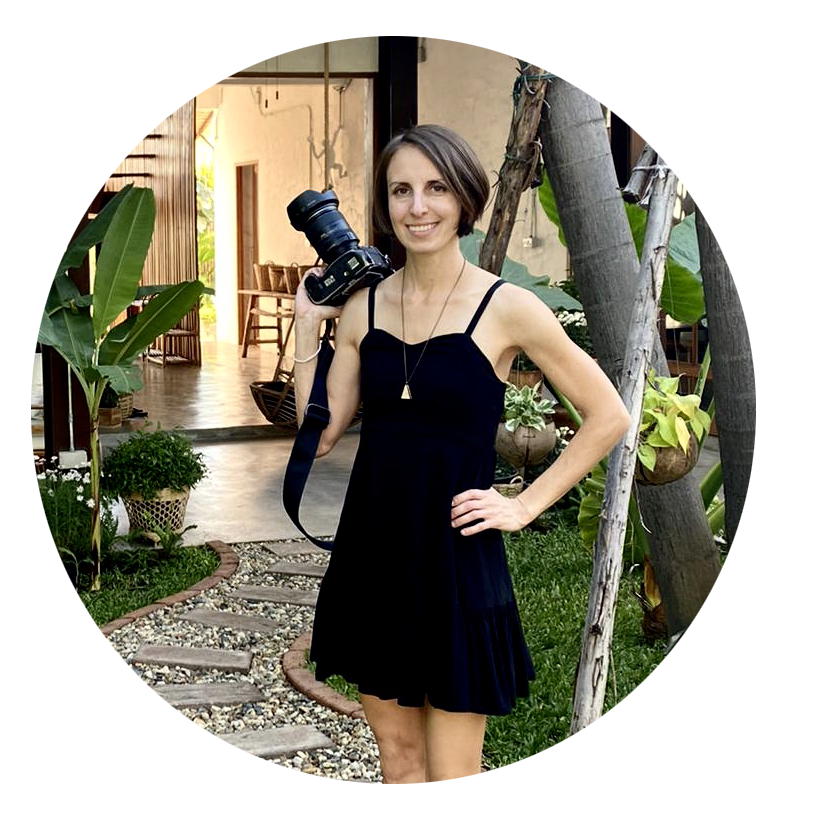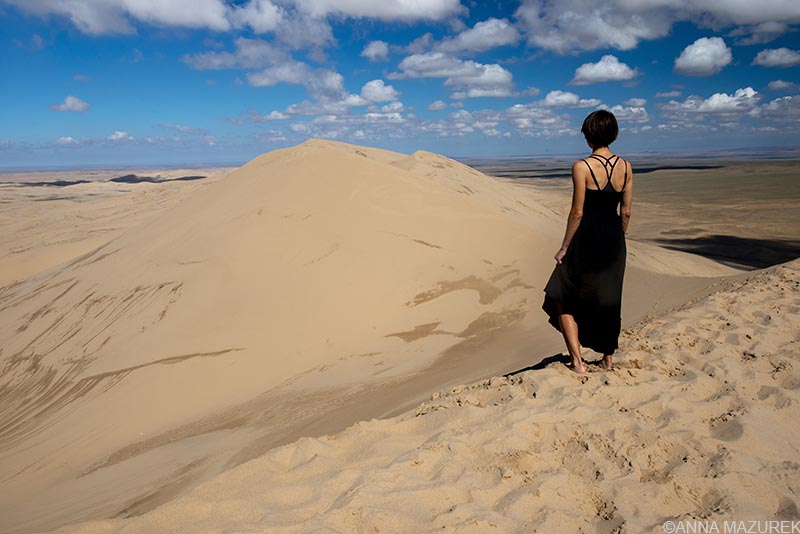
I’m THAT friend. The one that texts you on a random Thursday in April with a travel proposition you can’t turn down.
“How do you feel about a trip to Mongolia in August?”
My text to my friend Nick was prompted by a note I’d found in my phone from 2014—a bucket list. Riding a camel in the Gobi desert was number six on the list. Mongolia has been in the back of my head for ages. Like Kilimanjaro, I tried unsuccessfully to get hired to run photo trips in Mongolia so I could go for free. There was always some excuse not to go, which rotated between the distance, time and money. When I went freelance full-time, Mongolia moved to the top of my list because I finally had the time.
Nick lived in Japan so it wasn’t too far him. We had traveled to Burma together five years prior so I knew he was up for the adventure in a remote corner of the world. Plus, he is also a photographer and loves to eat as much as I do. (Plus, he always packs the BEST snacks!) He agreed instantly and we set off to plan an epic adventure that was my highlight of 2018. Here is a breakdown of our trip and where to go in Mongolia.
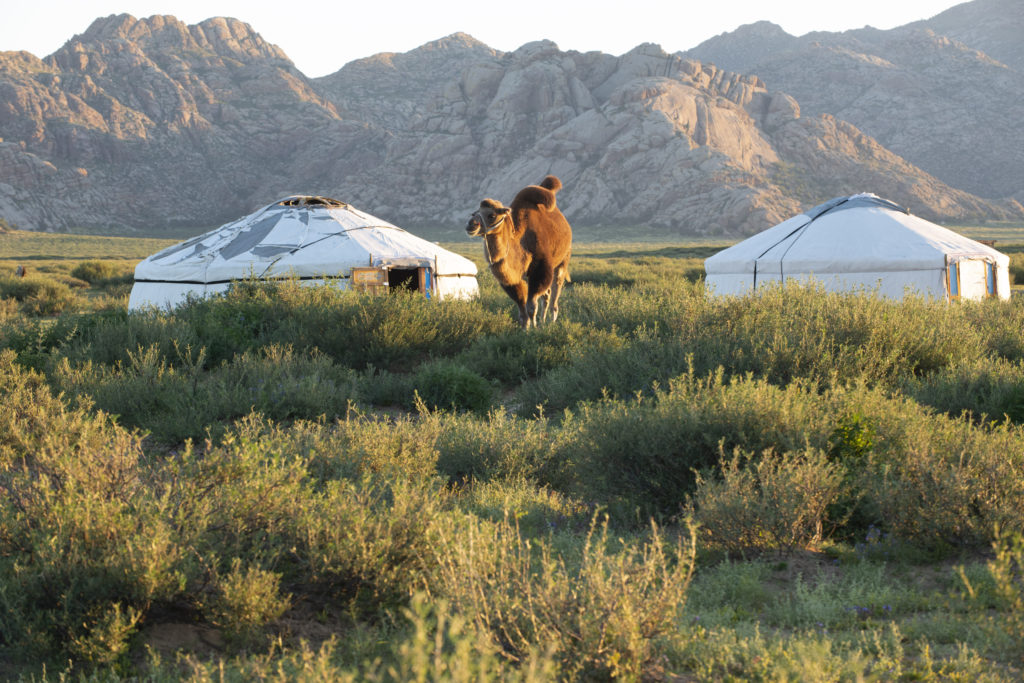
Everything You Need to Know About Central Mongolia & the Gobi Desert
In this post, I include all of the logistics, costs and details about Mongolia. I’ve also included a breakdown of our trip by day with observations about the route and life on the road. (Scroll down to the bottom for the packing list!)
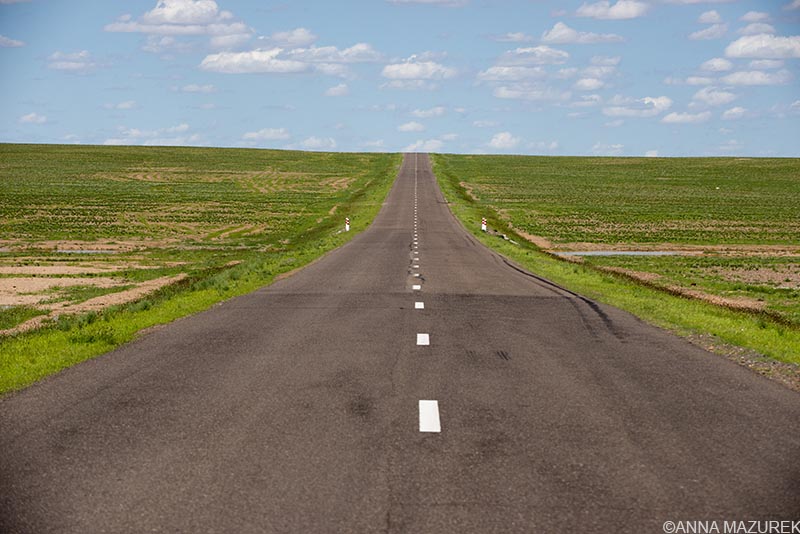
Do you have to take a guided tour in Mongolia?
The only way to do Mongolia is to book a tour. (And, I HATE tours, but there’s no way to drive yourself because there’s only a few main paved roads. Eighty percent of our trip was driving off-road through random fields with no signage.) We did our tour through the Vast Mongolia Guest House, which you can find on Booking.com, and loved it. A friend recommended a guide who organized the tour for us and found other people to join the trip to cut down the costs, which is a common practice. We ended up with five people on our trip including myself and Nick – Jorge, a Spanish chemist; Lisa, a British archeologist and Peter, a Canadian travel nurse based in Doha, Qatar.
Mongolia is so large that you can’t do the entire country in one trip unless you have a few months to spare. We opted for the 12-day Gobi Desert and Central Mongolia tour since Nick had limited vacation days. And, I had to be back in Texas for a big freelance project.
Food was included in the trip. Our guide and driver cooked really great meals every day!
Accommodation & Toilets
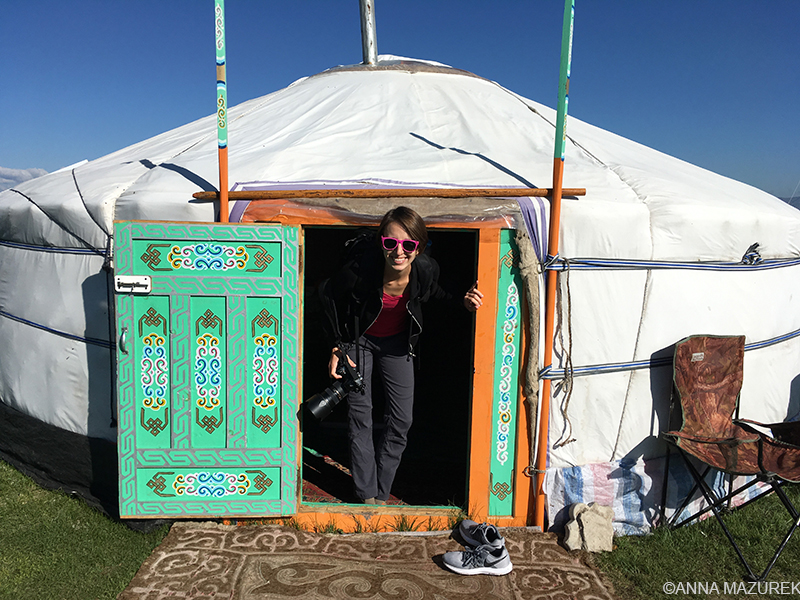
We stayed in ger (large round tents) camps every night except in Ulaanbaatar when we were in a guesthouse. A few of the camps were homestays where there was a family living in the camp with animals. We had individual single beds each night except for one night when we slept in sleeping bags on the floor at a homestay. Other camps were more geared to tourists so they didn’t have livestock nearby. Only three camps had showers for the entire 12-day trip. Bathrooms were always pit toilets or outhouses even when we stopped in cities. There was no running water outside of Ulaanbaatar.
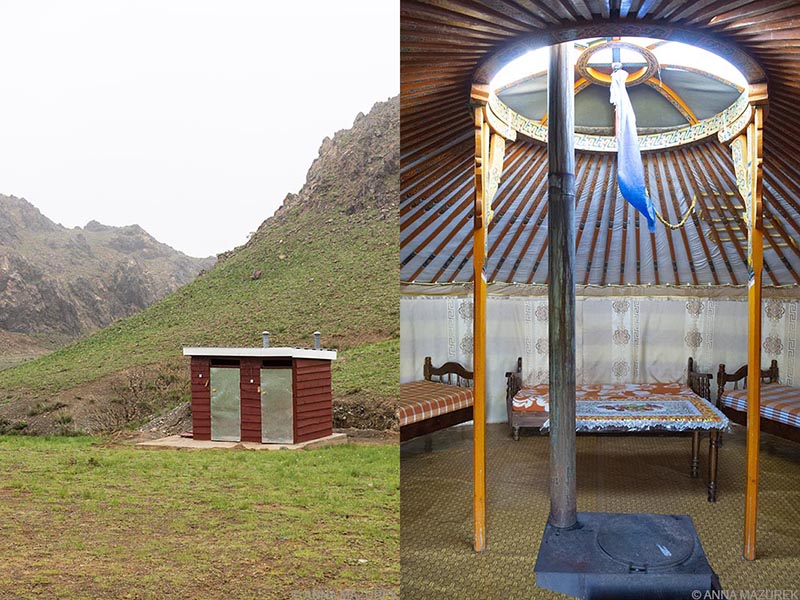
Most of the gers had wood stoves with vents to keep us warm at night. There was only one night was I was really cold. Most have power for a few hours each night to charge your devices. We could also charge our phones in the van.
Day 1: Chingis Khaan Horse statue & Terelj National Park
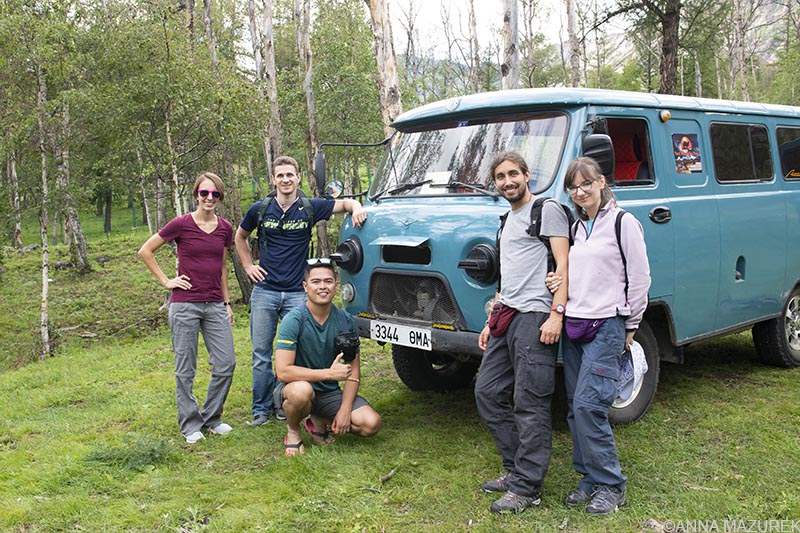
The minute I saw Boris, it was love at first sight. Boris was our home for the next 12 days—a dark blue teal Russian van with pink interior. He was always the coolest van in the parking lot. (FYI: We named him Boris ourselves. He clearly looks like a Boris.)
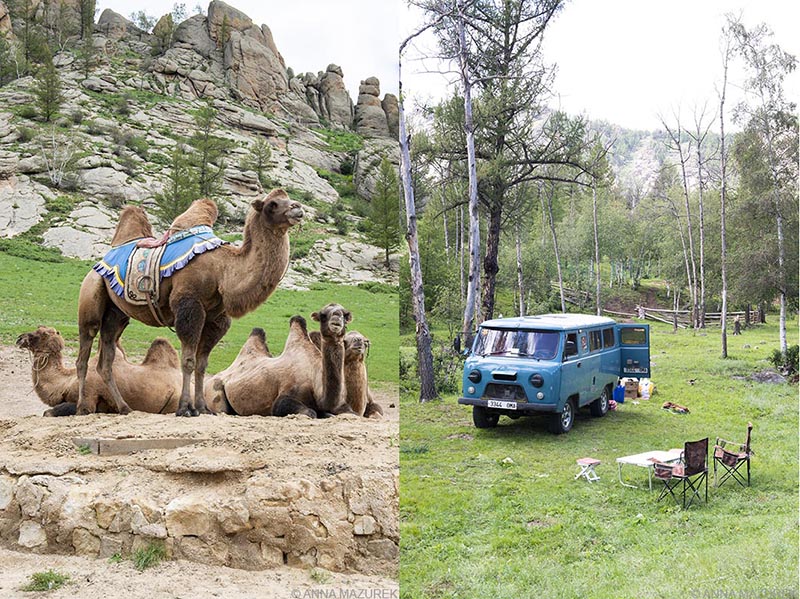
Our driver, Otgoo, was the Mongolian version of MacGyver and Chuck Norris. He was the nicest guy, worked hard and could fix anything. He knew everyone and the younger drivers all said he was their role model. He could take the entire tire off the van in just a few short minutes. It was unreal. (Let’s just say if the zombie apocalypse ever arrives, I want to be on Otgoo’s team!)
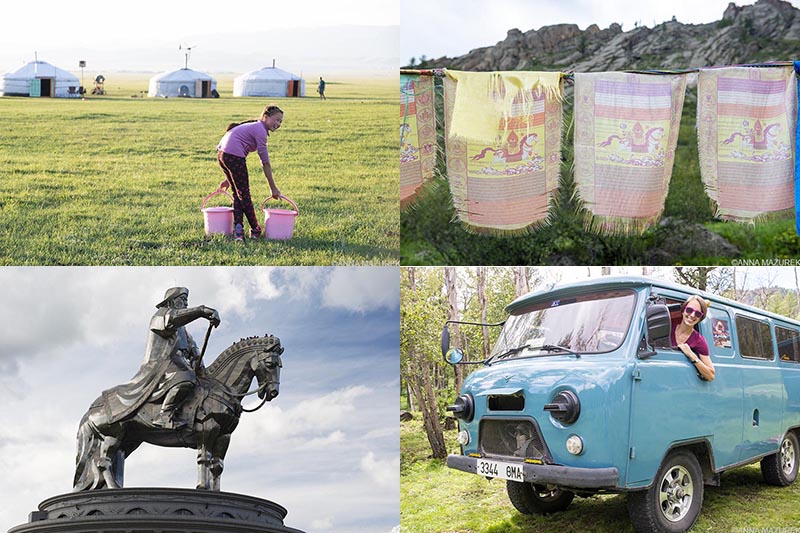
Our first stop was Terelj National Park, which is close to Ulaanbaatar. We rode horses to Aryapala Temple Meditation Center, a Buddhist temple that reminded me a bit of India. My horse decided to go rouge and ran under some tree branches. I almost fell backwards off the horse like a scene from a Bugs Bunny cartoon. My shoulder and hand got scraped up, but I survived with a good story. The next stop was super touristy but a must-see—the giant Chinggis Khaan horse statue. It’s 131-feet tall and points east to his birth place. Oh, it’s Chinggis (pronounced “Ching+ gus”), not Genghis.
Day 2: Baga Gazriin Chuluu
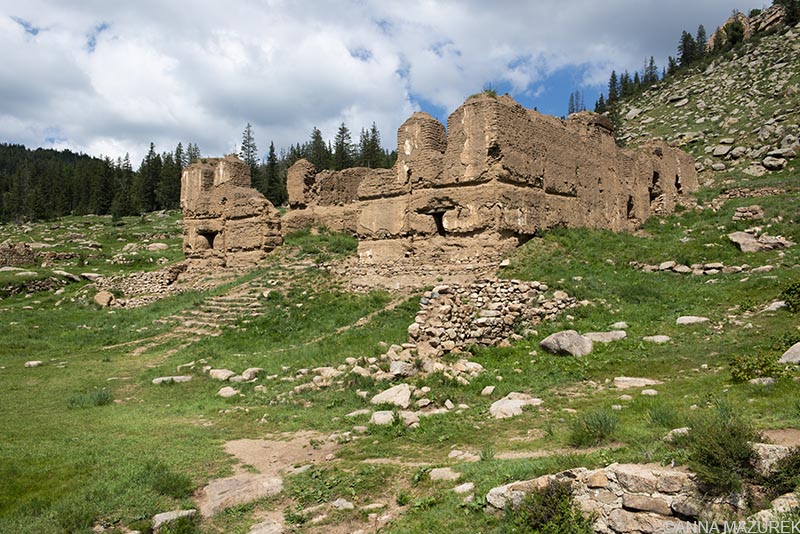
Our first stop was the ruins of Manjusri Monastery, one of the many monasteries destroyed by the communists during the 1940s. The monks were either killed or forced to renounce their faith. Travel is always an excellent lesson in world history and a stark reminder of the reach and wrath of WWII. Above all, I hope it is a lesson for younger generations to not repeat the sins of the past.
We drove for ages and the driver turned off the paved road onto an unmarked dirt road—tire tracks through a field. There were no signs indicating where we were or where we were going. The driver just knew where to turn and sped across the field. This one of many moments of awe on this trip. We would spend a majority of the next few days driving through fields covered in a spiderweb of tire tracks going in all directions. The ride was always bumpy and inside of the van was padded a bit to absorb the shock a bit. Nick and I couldn’t understand how Otgoo knew where to go when everything looked a like, and there were no signs!
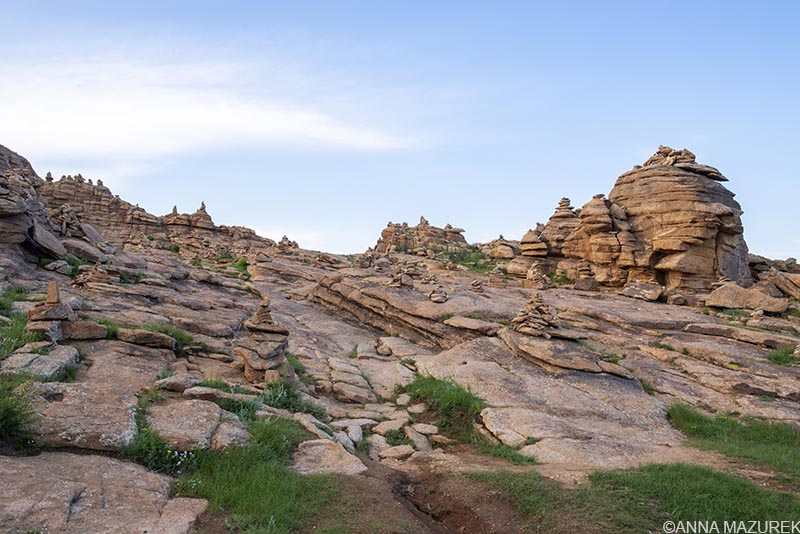
We ended up at Baggu Garzriin Chuluu, a set of crazy rock formations that reminded me of northern New Mexico. There was also a small cave and tons of rock piles scattered about.
One of the highlights of the day was when we stopped to pee. We pulled over on the side of the road in the middle of nowhere by an abandoned building with a pen for herding animals. No one else was in sight. The minute one of the girls had her pants down to pee, two boys on a motorcycle appeared around the corner to round up horses in a pen beside building where she was squatting down!
Day 3: Middle Gobi & Tsagaan Suvaga
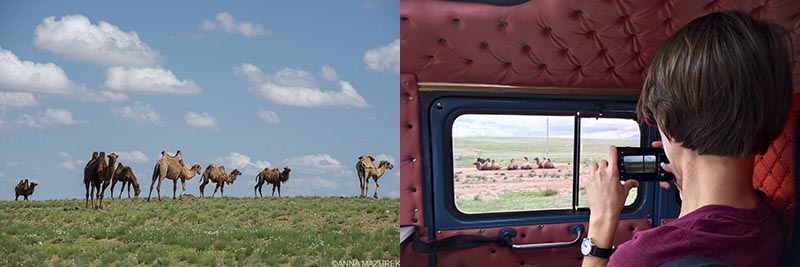
The highlight of the Middle Gobi was the drive. The scenery was flat, filled with green grass and patches of sand. At one point, I saw a herd of animals in the distance—too big to be sheep and not quite the right shape for horses. As we got closer, I saw the humps—a herd of two-hump camels! There is nothing that I love more than camels (except for breakfast tacos). I insisted that we stop for a road-side photo shoot!
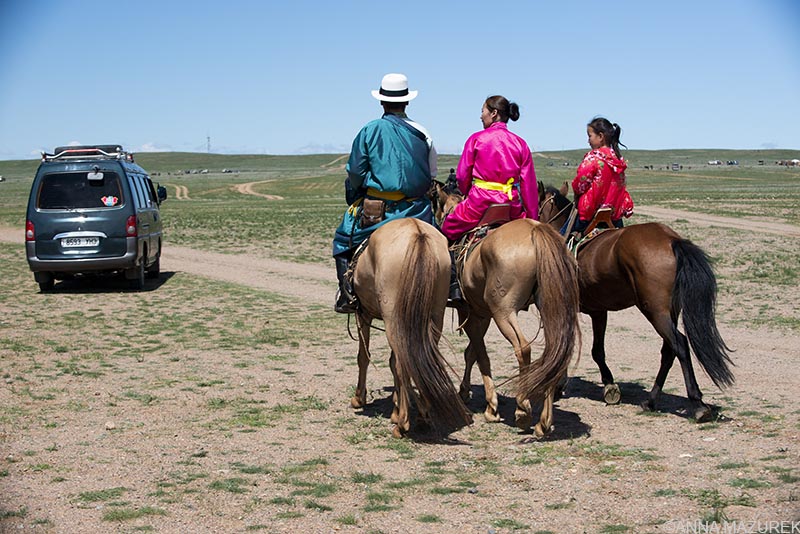
Our next stop was a town called Luus for a local village Naadam, a traditional festival in Mongolia. It’s held in July every year across the country but a few villages in the Gobi have a mini-Naadam in August. There were horse races and wrestling. We tried fermented horse milk, which tastes about as good as it sounds.
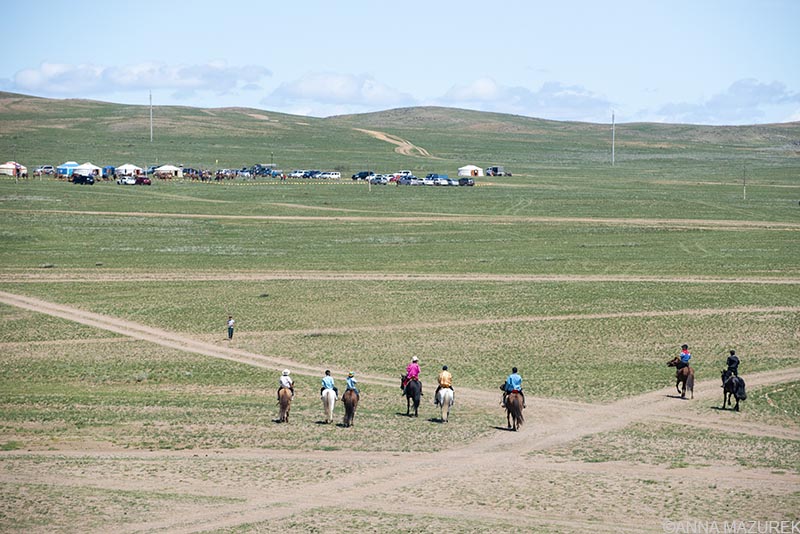
Mongolians all appear to be as addicted to their phones like the rest of the world. There were more towns than I imagined and cell service was quite frequent outside of the Gobi. People use motorcycles to herd animals instead of horses. It was much more modern than I expected. (I bought a SIM card that worked almost everywhere except a few spots in the Gobi.)
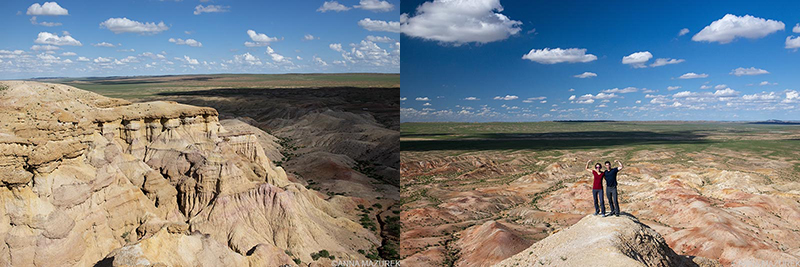
We stopped by Tsagaan Suvarga, a viewpoint over a series of rock dome formations and red sand cliffs that resembled parts of Argentina.
Day 4: Yoliin Am & Southern Gobi
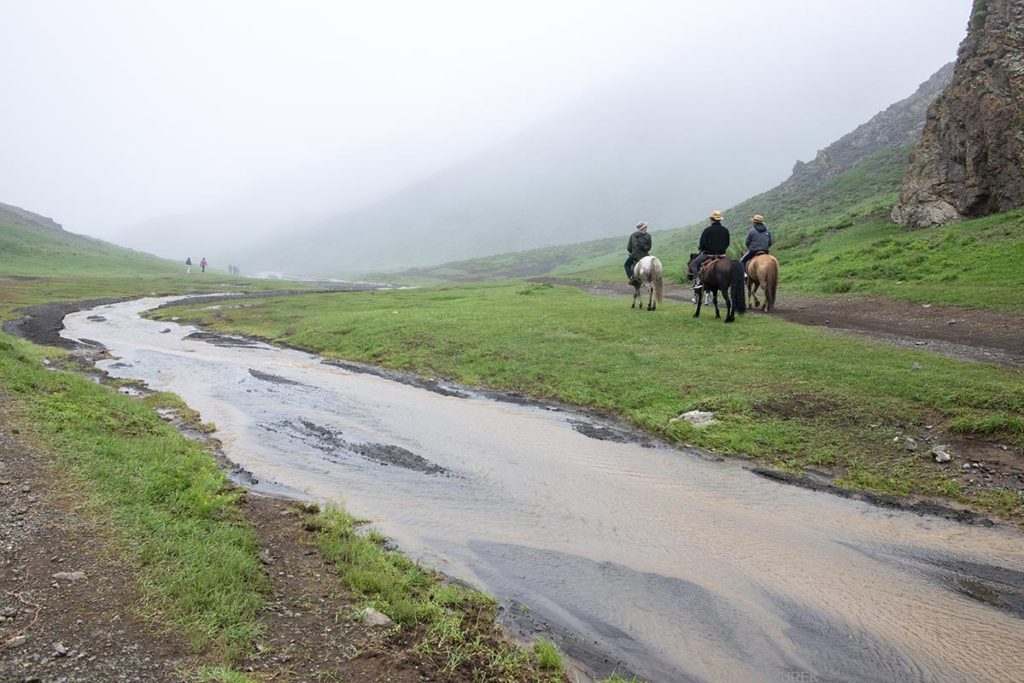
Rain during the night made the roads a bit messy and slowed down our progress. The weather was dreary, foggy and overcast as we drove to Yoliin Am, a range of high, narrow canyons split by a river that supposedly remains froze until July. (We were there in August, and it was flowing especially after the rain.) We hiked about 10 kilometers into the canyon in drizzly rain. It was a bit slippery at times on the rocks. The weather really set the mood and made for better photos than sunny weather, I thought.
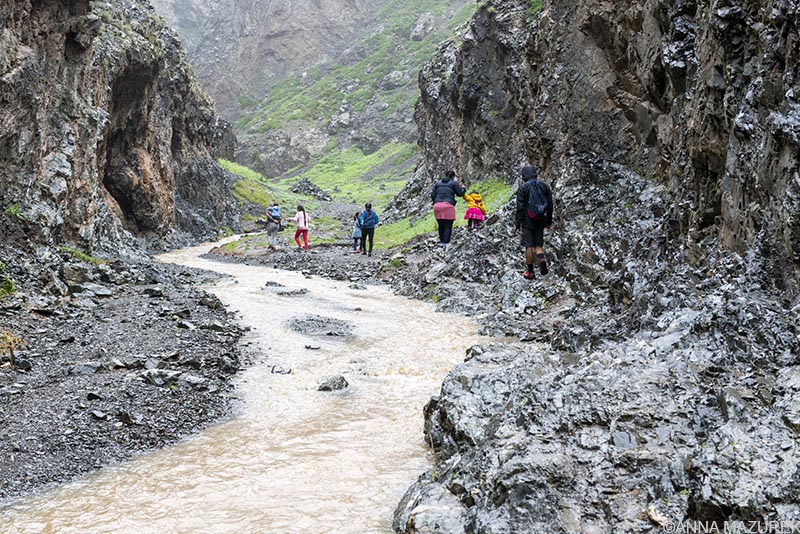
The museum at Yoliin Am had the most horrible taxidermy animals that I’ve ever seen. All of the Mongolian museums were this way. My favorite had an eagle with marbles for eyes—terrible, scary and hilarious.
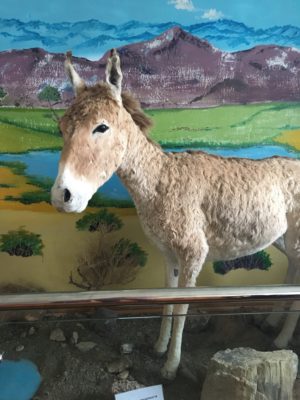
After we made it back to the van, the rain started to pour and the road washed out in places leaving regular cars stranded. Boris—our badass Russian van—made it out okay. Otgoo is seriously the best driver ever!
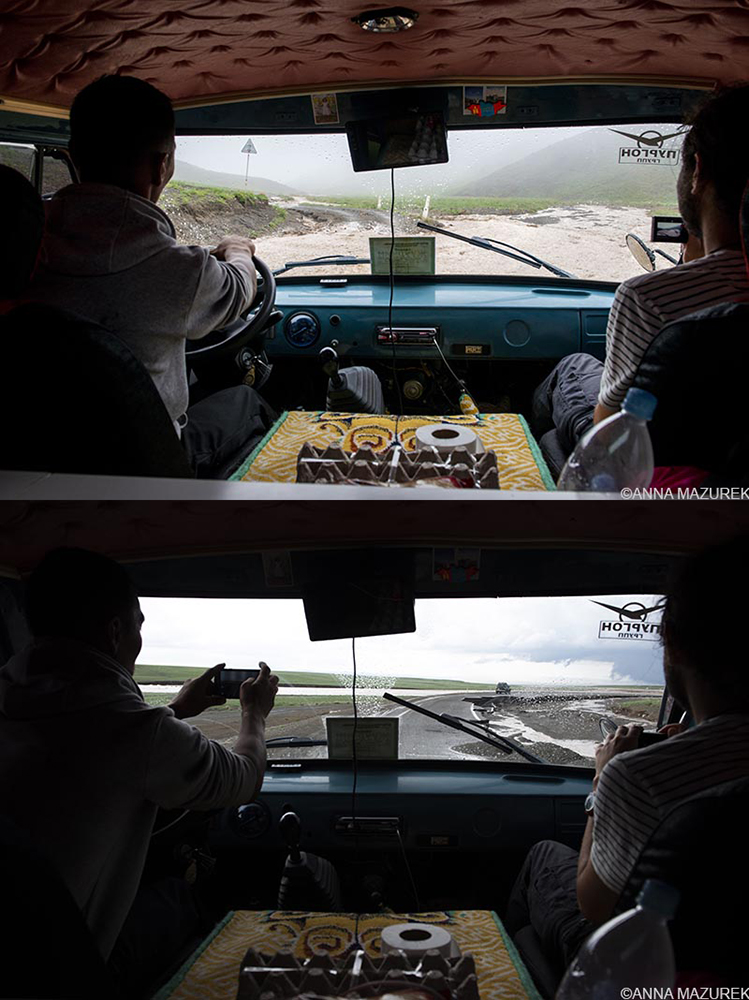
The main paved road nearby was washed out and collapsed in places due to the rain. We made it to the Gobi desert that night to Khongoryn Els, the main attraction in the Southern Gobi—the largest sand dune in a 180-kilometer long field of dunes. THIS is exactly why I’d flown across the world.
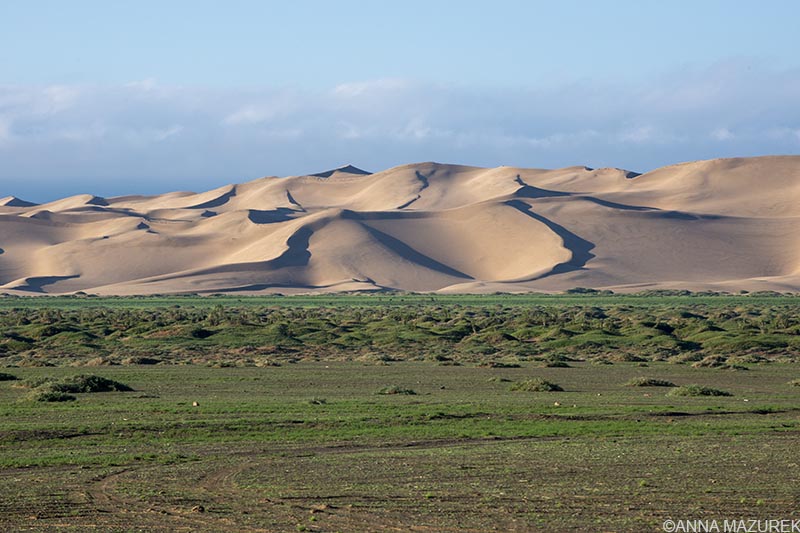
There was a set of two-hump camels outside the ger camp when we arrived. I immediately started taking photos since the light was fading as sunset approached.
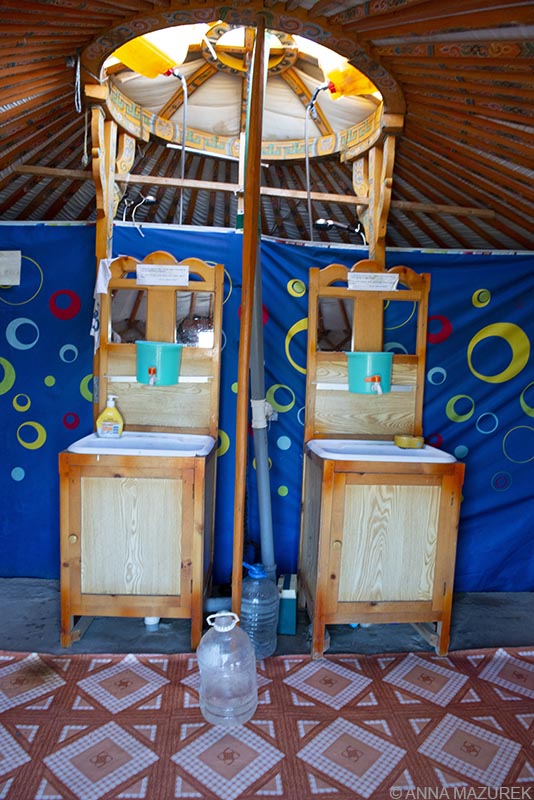
By far, this was the nicest ger camp of the trip because it had a proper shower ger! I got my first shower of the trip, which was so exciting! (The water pressure was terrible, and the water was REALLY cold. Still it felt great to be clean!!) The dining room also had tall table and regular height chairs, the first time we didn’t have to sit on the floor or short stools.
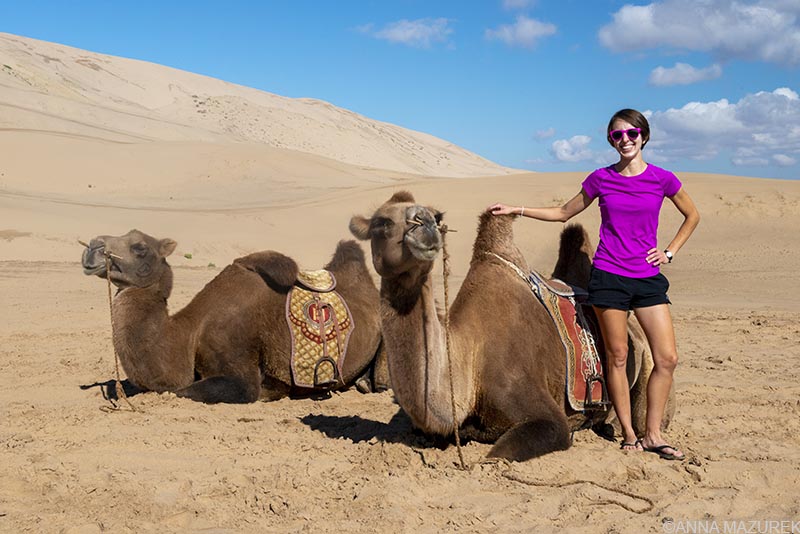
We took a sunset camel ride, which was lovely. The stars at night were amazing. Our visit aligned perfectly with the Perseids meteor shower. The Milky Way was on full display. We spent a good amount of time each night staring up at the sky watching for meteors.
Day 5: Gobi Desert & Flaming Cliffs
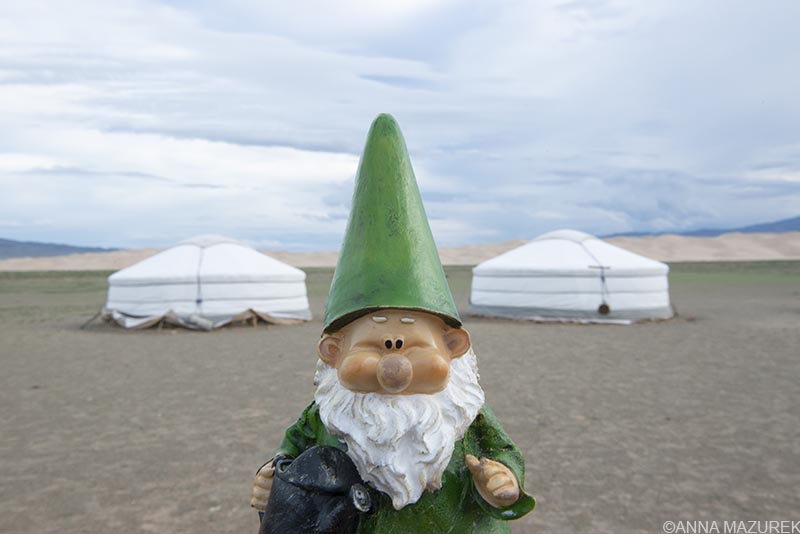
I got up at 6:30 a.m. to shower and take photos. I’d brought one dress to wear in photos so I wasn’t wearing my dirty hiking clothes in every shot. We drove out to the base of the sand dunes just as a man walking with two camels arrived. I was like a kid on Christmas morning taking photos of the camels with the dunes.
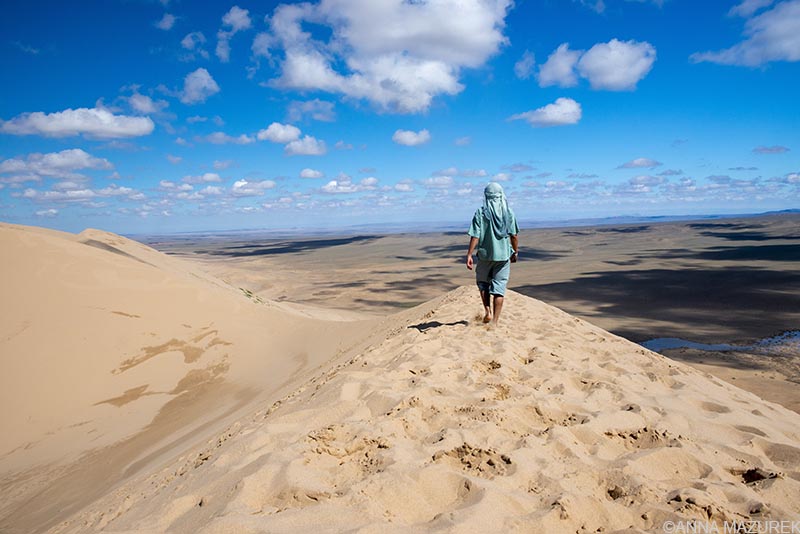
We started to climb the sand dunes at 9 a.m. It took 30-40 minutes just to get to the top! Climbing sand dunes is much HARDER than it looks! The view was amazing. We took silly photos, which is my favorite thing to do when I travel.
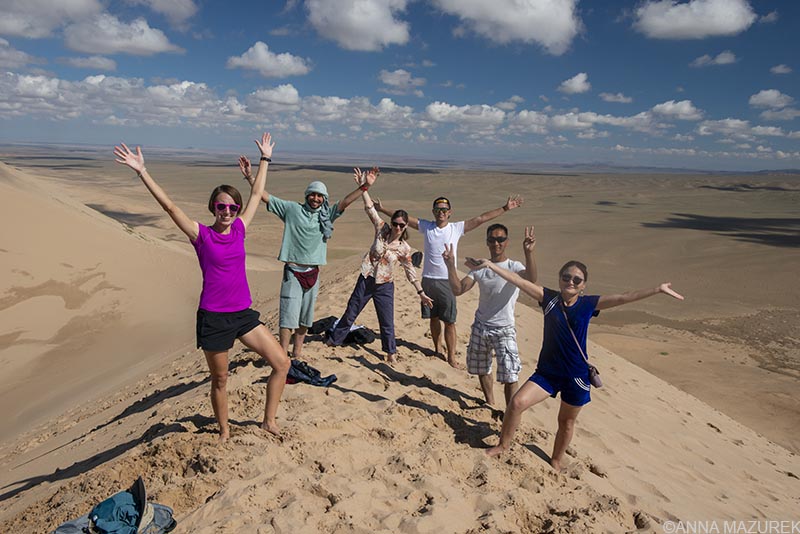
Today was the most amazing day of the trip. It was totally worth flying across the world for this. I’ve been obsessed with remote corners of the world for the past 10 years. It started with my first trip to India. This area is one of the most remote. It’s peak tourist season yet it doesn’t feel touristy. We had the dunes to ourselves except for a handful of people at the base!
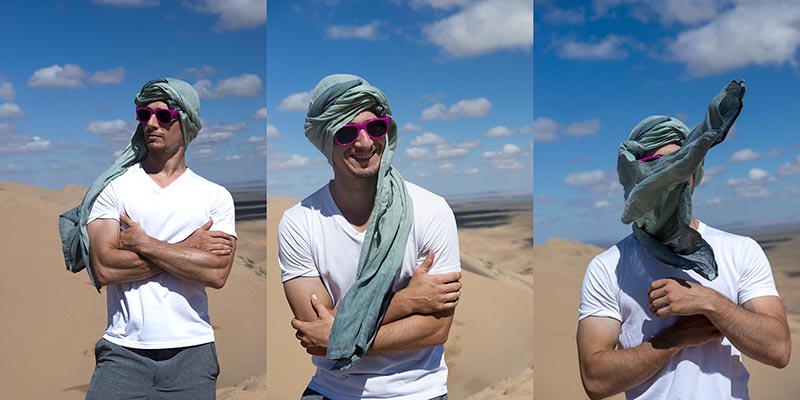
We are only five days into our trip, and it feels like months.
Nick made a profound statement in the van, “I feel like this has become my life, and I’ve forgotten everything else.” That’s my common mindset on the road—it feels like my current situation is all I know.
Today, the inevitable happened – we had some tire problems and spent a good hour on the side of the road. Otgoo literally took the wheel apart and greased the barring in the amount of time it would have taken me to jack up the van. He has a stash of tools under the backseat that he keeps in an old women’s purse. I’m impressed by his resourcefulness. The tire repair put us a bit behind schedule.
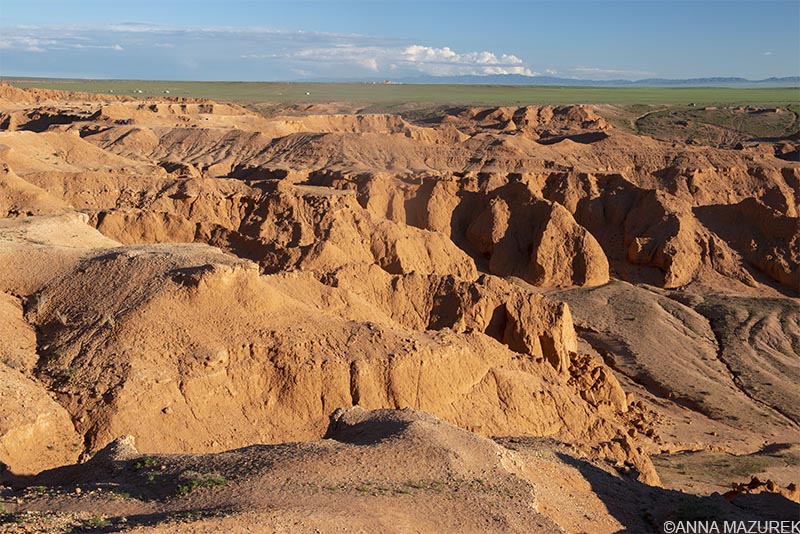
Our final stop of the day was the Flaming Cliffs, known as Bayanzag. The red cliffs are a haven for dinosaur bones including the first dinosaur eggs discovered. Velociraptor bones were also found here. I wish we’d had more time here but that’s how I felt about almost every place except for the spider ger, which I’ll get to in a bit.
Day 6: Local Nomadic Family
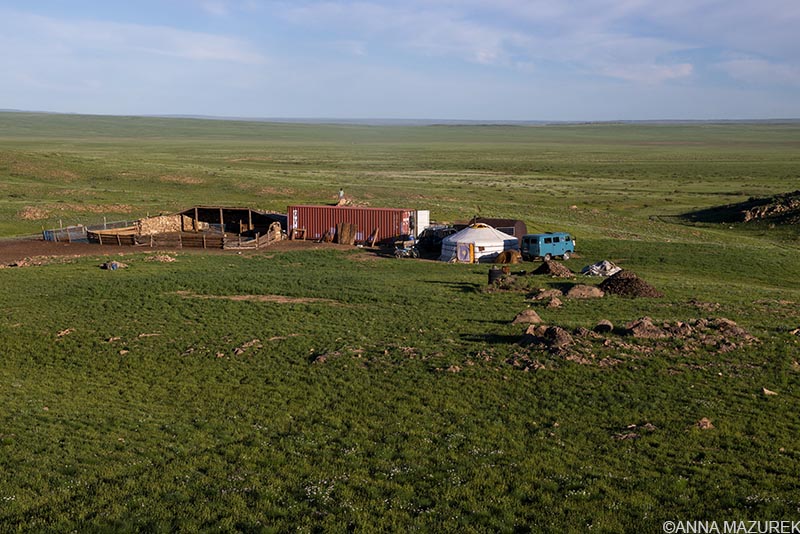
We dropped off Peter in a nearby town so he could take the bus back to Ulaanbaatar to catch his train. We spent the afternoon and the next morning visiting the family of the guesthouse owner in Ulaanbaatar. They lived in traditional gers and had a herd of goats. We got to milk the goats and try traditional food. Overall, it was a very chill but amazing day!
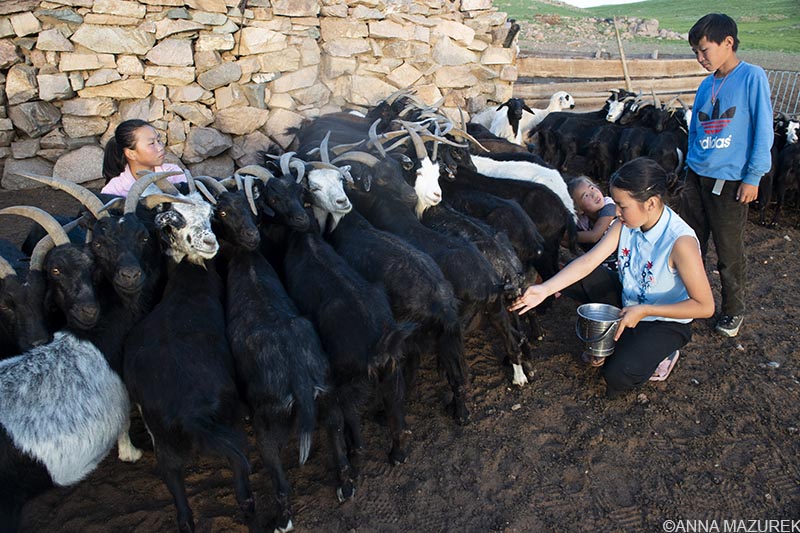
The meteor shower was amazing that night. Nick and I sat outside on tiny stools staring at the sky until our necks hurt. (I highly suggest planning a Mongolia trip around a meteor shower if you can!)
Day 7: Ongi Monastery
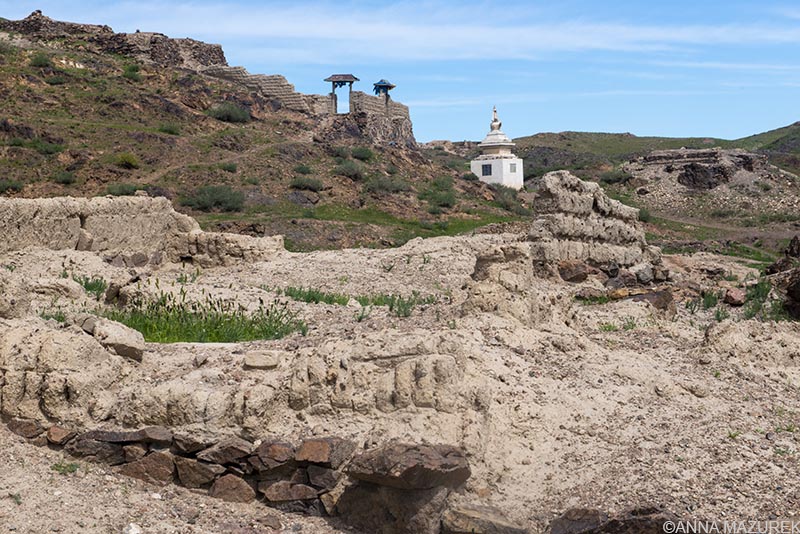
We drove until 1 p.m. when we reached the ruins of Ongi Monastery, one of my favorite places we visited on the trip. It was built in 1660 with 11 buildings. A new complex with 17 buildings was built in the 1800s. All were destroyed in 1939 by the communist anti-religious purges. The complex was huge and stunning!
We stayed in a nice ger camp by the river – the only river that runs through the Gobi. The camp has two luxuries we haven’t seen yet on the trip – cold beer and hot showers. It’s our third shower of the trip!
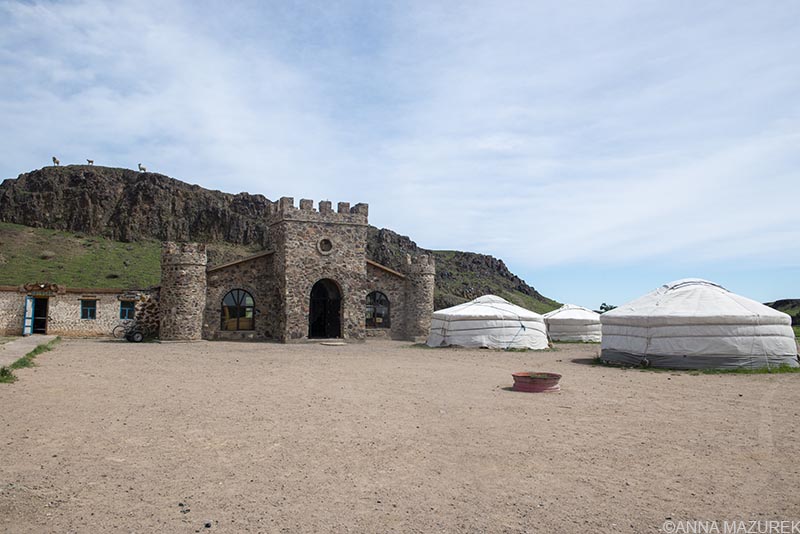
We’ve had to drink out of plastic water bottles supplied by our guide/driver because there’s been very little ground water in the Gobi. I hate plastic and brought a water filter but it’s been useless.
There are times Mongolia reminds of me of India except it’s cleaner, nicer. It doesn’t have the overpopulation issues that plague India. There’s a luxury camp next to our camp. It’s the only luxury accommodation we’ve seen since the Flaming Cliffs. People still have to take a van here. There’s no glamourous alternate route or airport. The environment is pristine with a bit of litter near cities.
The people are genuinely friendly in Mongolia because it hasn’t been overrun with tourism. (I don’t feel like I’m being scammed 20 times a day like I did in Vietnam.) Mongolia is still off the beaten path but has an infrastructure for tourism but hasn’t been poisoned by it. It’s refreshing and rare to visit a place that feels this way! I hope it never changes.
Day 8: Ulaan Tsutgalan Waterfall & Dance Party
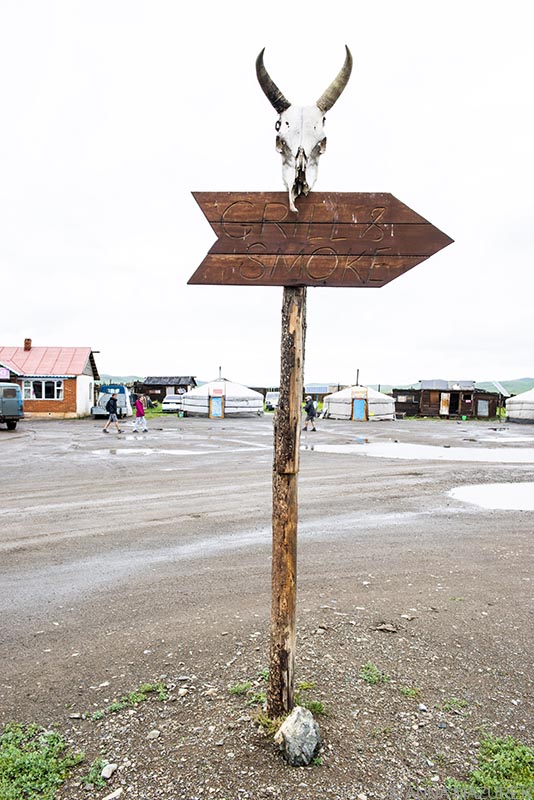
The weather was cold and rainy so I was grateful we spent the entire day driving even though it was all dirt roads. We stopped for lunch at a small roadside rest stop that looked like a scene from a zombie movie. An animal skull was hanging over a sign that said “Grill & Smokes” in front of a few haphazard buildings.
We stopped at an overlook at the Ulaan River, the longest river in Mongolia and reached the waterfall by 6 p.m. The falls were unimpressive, but the walk to the falls was through lush green valley filled with yaks grazing.
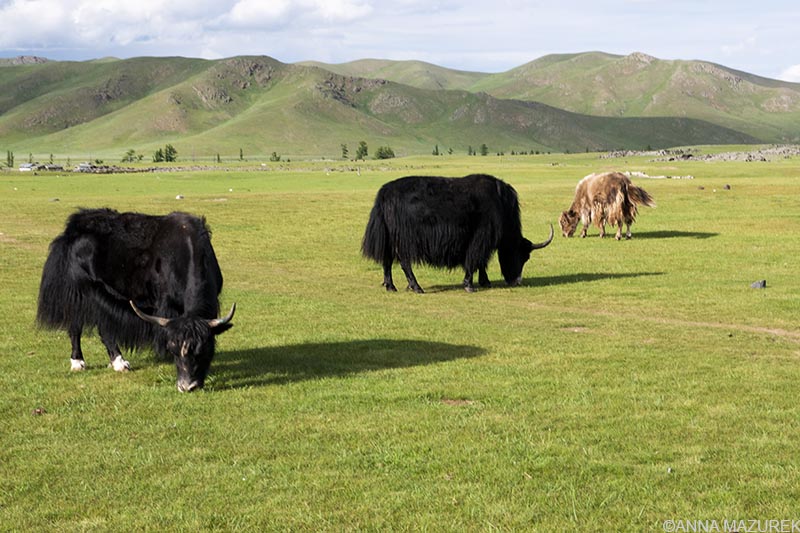
We couldn’t find our driver when we got back. Nick joked that he was probably killing our dinner. We found our driver a few minutes later. He’d literally just helped two guys slaughter a sheep!
We are closer to the capital now. There’s a lot more people and more ger camps. There was a lot of trash near the parking lot of the waterfall, which was gross and disturbing. It was the largest amount of trash we’d seen on the trip. I had flashbacks to India for a moment.
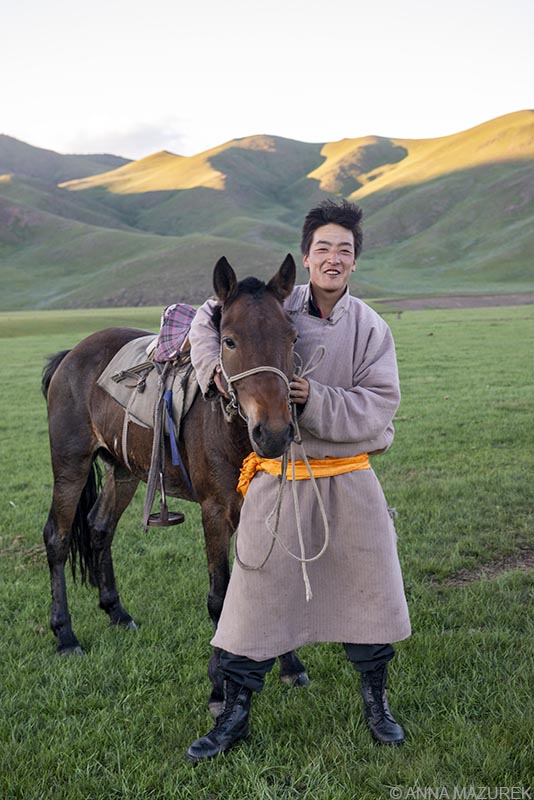
We had a huge bonfire at our ger camp to say farewell to Lisa and Jorge who were leaving the next day. Otgoo pulled Boris up to the bonfire so we’d have music. There were a few locals and other travelers—an Australian and some French girls. There we were in the middle of the Mongolia under the Milky Way singing along to Beyonce’s “Single Ladies” followed by some Maroon 5 and Backstreet Boys. We went through a couple bottles of vodka and a bottle of red wine between us, the drivers and the locals. It turned into a dance party and was one of the best nights of the trip!
Day 9: Tsenkher Hot Springs
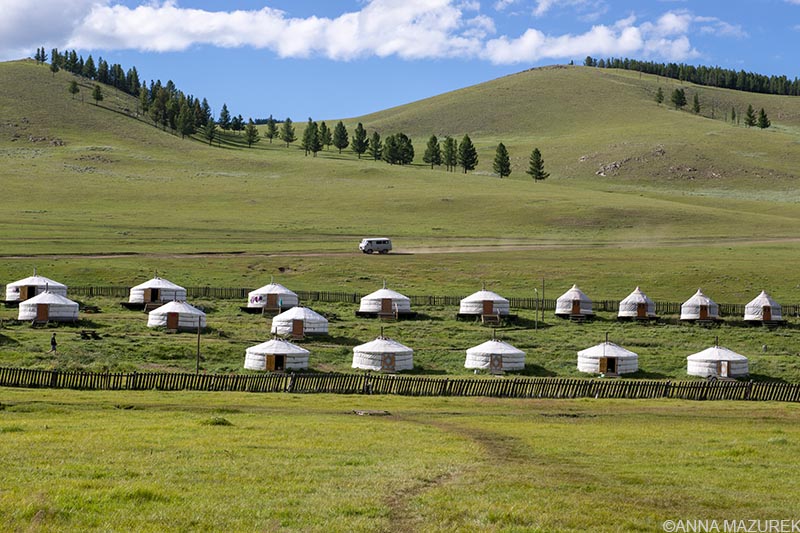
Nick and I said goodbye to Lisa and Jorge in the morning. Our next stop was the most touristy place of the trip—hot springs. (Why are people so enamored with hot springs? I’ve never understood it and never really enjoy them.) The water was piped into a series of thermal pools that varied temperatures. Our ger camp by the springs was one of the most photogenic place of the trip!
It’s crazy how much the landscape has changed as we drove. Yesterday, it was lush green grass with yaks. Today, the mountains appeared with a single row of tall trees along the rim that resembled spikes on a dragon’s tail. Marmots were running around everywhere.
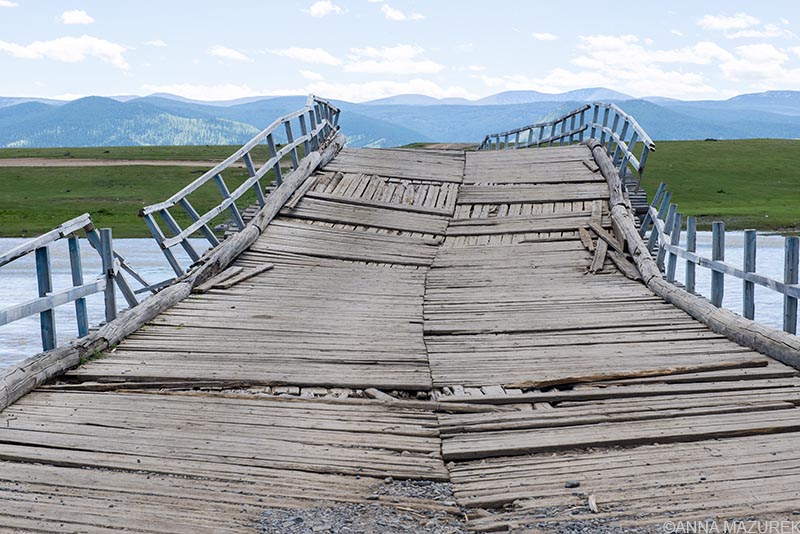
The road has been the worst today. I’ve been saying that to myself every day, but today, it’s true. Boris shakes nonstop. We crossed a sketchiest bridge today that was literally falling apart. It looked like it was made with toothpicks. Otgoo made us get out and walk across on foot. Then, he drove the van across. (Check out the photo above!!!)
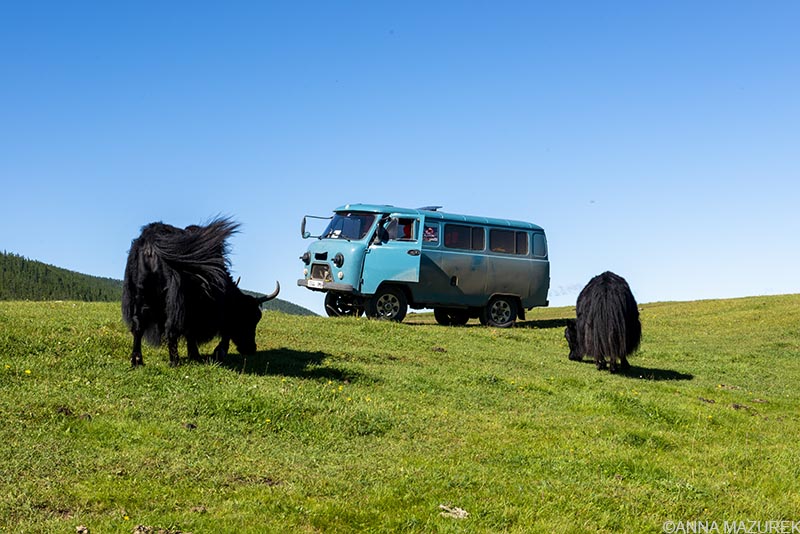
The nights have gotten colder as we’ve gone north. I can see my breath at night. It seems like most of the other travelers we meet are on the Trans-Siberian Railway and only have five days or so in between trains so they can’t see much of the country. I can’t wait to come back to spend more time in Mongolia to explore the North and other regions. The train is also on my list. (If you are taking the train, give yourself a few WEEKS, not days to explore.)
Day 10: Kherogo, Terkh & Crater Lake

We stopped for lunch by a small scenic stream. Otgoo took off the front right wheel of the van then walked into town. Four hours later, he came back with new brake pads. He’d basically hitchhiked to another town to get them! Due to the daily, we arrived at the lake after sunset.
Day 11: Khorgo Crater, Terkh National Park & Karakorum

I woke up at sunrise to take photos. The ger camp and lake were stunning. We hiked up the Khorgo Vul Volcano carter and walked along the rim. We were above 6,000 feet in elevation so I could feel the altitude a bit. Apparently, we spent too much time on the top, and our driver called our guide to tell us to walk down the opposite edge of the crater to meet him on another road on the other side. We literally hiked down the backside of the crater, which was filled with little rocks. We kept sliding and falling the entire way. It was a nightmare, but we made it back to Boris!

Our ger was covered in spiders. I tried to catch a few and take them outside. I hate to kill them, but there was just too many. We ended up killing more than 10! It was like a horror movie. Nick even found one in his sleeping bag!!! We were both ready to get back to showers and clean beds.
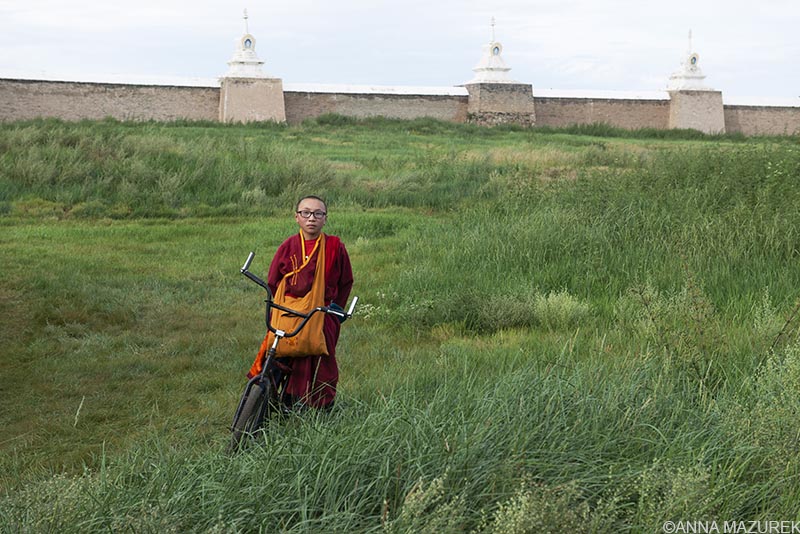
It was just before 6 p.m. when we reached Karakorum, a supply base established by Chinggis Khan in the 1300s. It’s a huge walled complex lined with stupas. There’s a large temple complex and monastery with monks. We arrived right before it closed so we rushed around trying to go inside before the buildings closed. It was my favorite monastery in Mongolia.
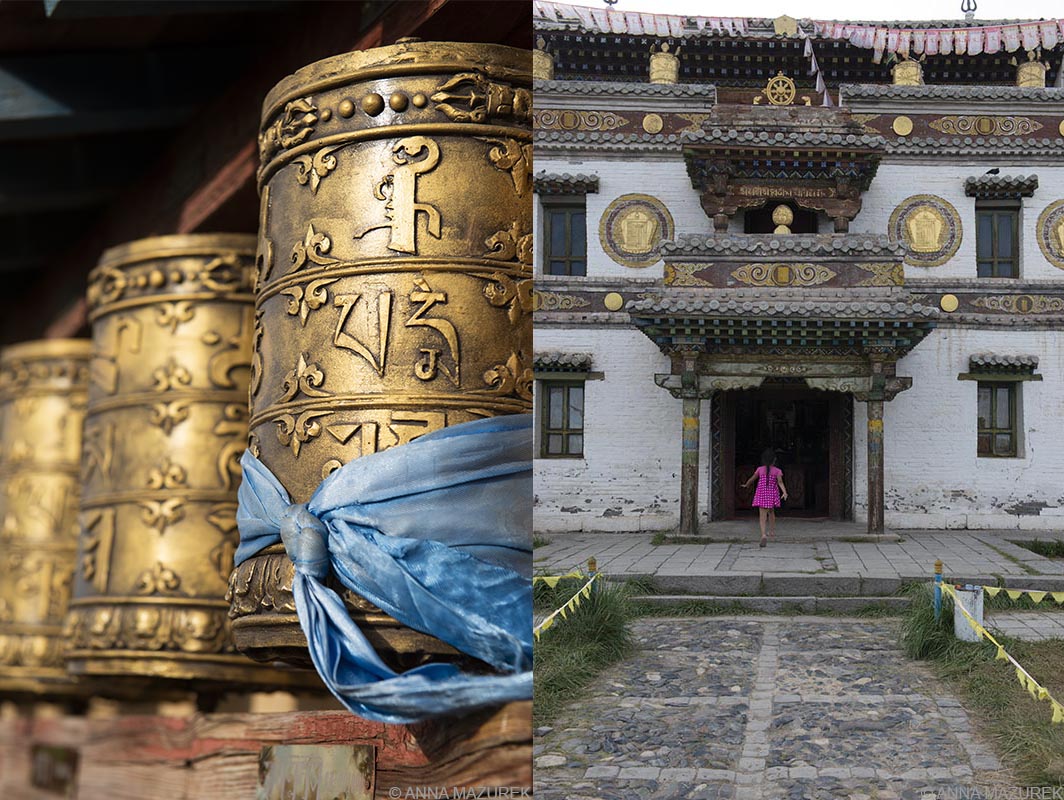
 Left: Prayer wheels in the monastery inside the Karakorum complex. Right: A little girl walks inside a temple
Left: Prayer wheels in the monastery inside the Karakorum complex. Right: A little girl walks inside a temple
Nick and I had Otgoo stop the van so we could take portraits of him with Boris in a field outside of town.

We spend the night at a ger camp near 30 kilometers of small sand dunes reffered to at the mini-Gobi. (It’s close to Ulaanbaatar so people will often go here if they don’t have time to go to the actual Gobi.) When we arrived, there was a lone horse tied to a pole and no other animals around the camp.
Right before bed, Nick was outside the ger brushing his teeth in the dark. He yells “Anna, come look at this!” I walk out with my headlamp but can’t see anything. He tells me to come closer. All of a sudden I see three pairs of eyes that belong to three two-hump camels tied up to the same pole the lone horse had been tied to before. I literally squealed—camels lived in our camp!
Day 12: Khustai National Park & Ulaanbaatar
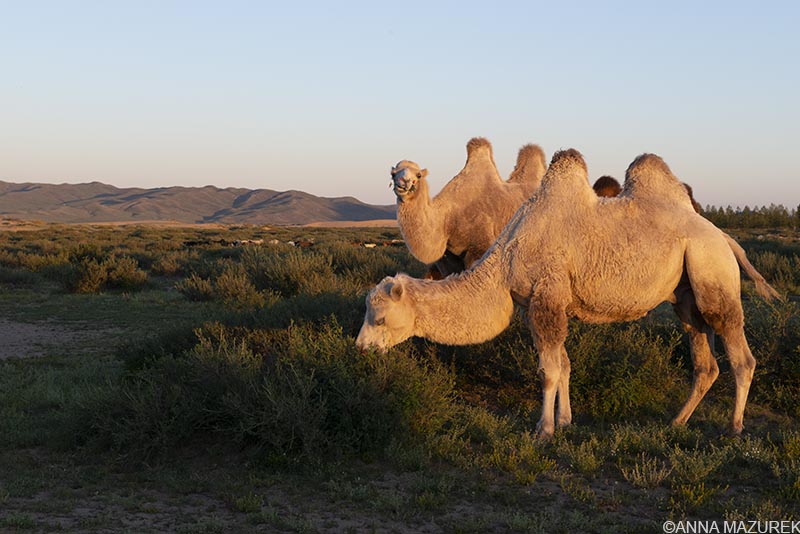
I got up at sunrise to photograph the camels. I’d set my alarm for 6:30 a.m. but woke up at 6:15 a.m. when I heard people outside. I opened the door, and the camels were gone. Heartbroken, I grabbed my camera and walked around the side of ger. I found the camels – they were munching on the grass nearby! The best part was that they’d multiplied overnight—there were five now! I photographed the camels and the local family for over an hour. I’m pretty sure the family thought I was crazy chasing the camels with my camera!
The food has been surprisingly amazing. For dinner last night, our guide made fried dumplings. For breakfast, they made us pizza – perfectly pan-fried crust with cucumber, potatoes, cherry tomatoes and eggs with pasta sauce. It was phenomenal.
We arrived at Khustai National Park in the afternoon, which is known for wild horses. (The horses were extinct in the wild, but a few were in zoos. They were bred in zoos and released again successfully in the wild.) We saw the horses right way on the rim of a nearby hill. We walked closer to get photos but couldn’t get too close due to park regulations.
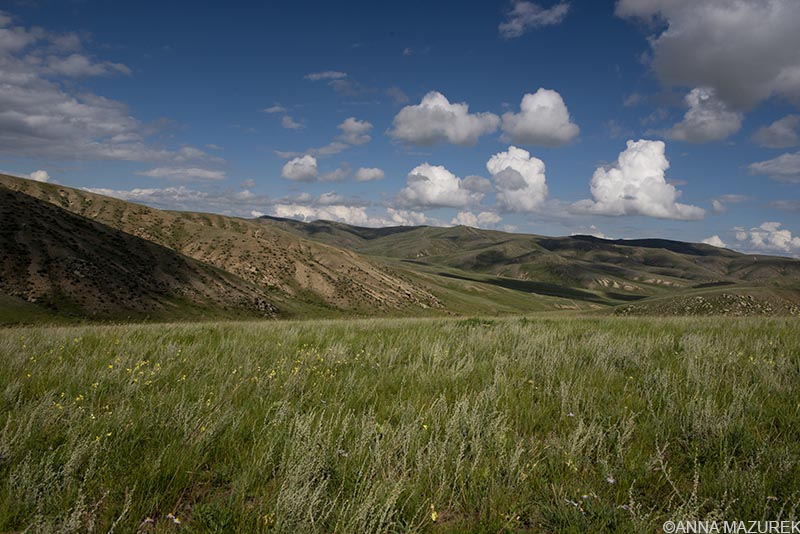
We were sad to see our tour end because we couldn’t imagine our life without Boris. We arranged a post-tour dinner with our driver, guide and Peace, the guide who put our tour together. We went to a brewery and ended up in a karaoke bar. Nick was great at karaoke because he has lived in Japan — the land of karaoke — for 10 years. Of course, Otgoo was amazing. He’d been a drummer in a band and was amazing at singing the Mongolian songs. I couldn’t think of a better way to end the trip! It was well after midnight when we got back to the guesthouse.
_____________________
The Best Time to Go to Mongolia
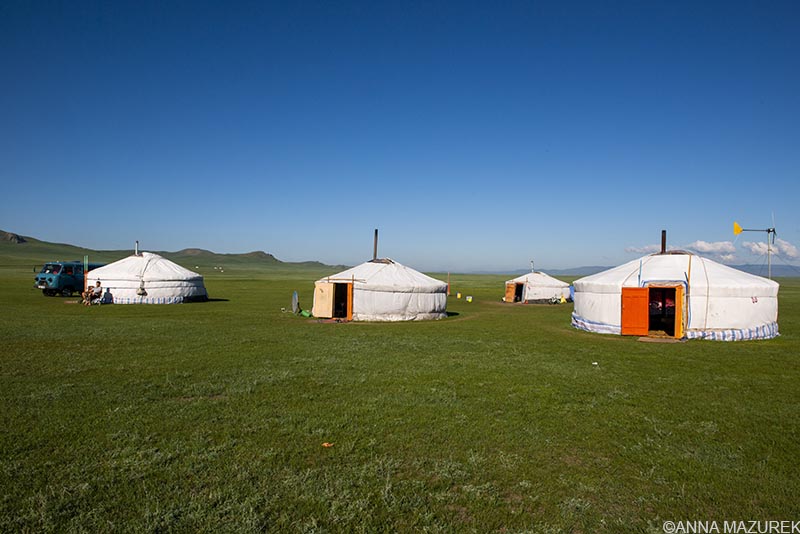
High-Season: June to August
Warm and mostly dry weather are the norm in June and July. Cooler temperatures and rain move in during late August. Book everything in advance around Naadam in mid-July. (2019 dates are July 11-15th.)
The eagle festivals are held in September and October in Olgii and Bayan-Olgii. Some ger camps and guesthouses close in the shoulder and low season. It’s frigid in December/January and air pollution is terrible in Ulaanbaatar from all the smoke from the wood stoves. Winds and dust storms are bad in March and April.
If you want to visit the reindeer people in the north, it involves a three-day horse ride in the summer months after driving for days. In May, it only involves a one-day horse ride but still in involves a few days of driving.
How much does it cost to go to Mongolia?
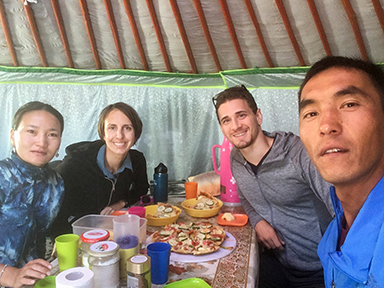
Our tour cost about $1,200 each for Nick and I. The cost varied per day on our trip since the amount of people on tour fluctuated. (The average is $30-50 per day per person for a budget tour.) I booked my flight in May for my August trip. It paid a little less than $1,300 roundtrip from Charlotte on United Airlines. I had a layover in JFK and Beijing. On the way back, I opted for a 12-hour layover in San Francisco to visit a friend. Then, flew back via DC to Charlotte. (This long route back saved me $500 on the airfare.) Overall, I spent about $2,800 for the trip. The additional $300 was driver/guide tips, airport taxis and food/accommodation for two days in the capital after the tour ended. It was one of the most expensive trips I’ve ever taken but totally worth it!
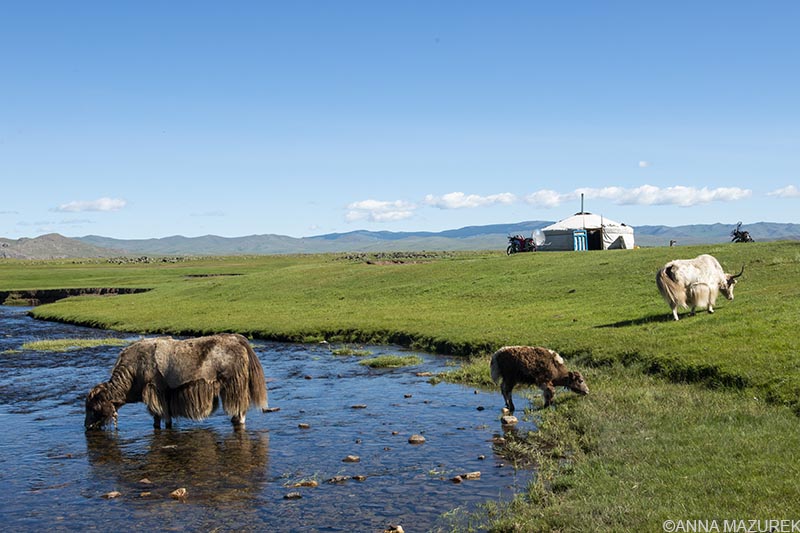
Packing List for Summer in Mongolia (June-August)
- Headlamp
- Wet Wipes & biodegradable soap
- Hiking boots
- Flip flops for communal showers, walking around the ger sites & the Gobi (A pair of black Haviana’s are my personal favorites for traveling!)
- 2 pairs of hiking pants & 1 pair of jeans for Ulaanbaatar
- 1 pair of long pants for sleeping
- 1- cotton tank for layering
- 5-7 shirts
- 1- long sleeve thermal shirt
- 1- long sleeve sun shirt for Gobi
- 1- wide brimmed travel hat
- 1-pair of shorts for the Gobi desert
- Scarf
- Hoodie and a zip-up fleece
- Raincoat to layover hoodie or fleece
- Snacks (peanut butter packs, nuts, granola bars)
- USB-cable for charging phones in the car
- Sunscreen (I recommend the natural chemical-free kind.)
- Sleeping bag liner (Sleeping bags are often provided so this liner is critical!)
- Undies and socks (I tend to pack one-pair per day for trips where laundry is difficult like this. I recommend 5-7 pairs of hiking socks for hiking and keeping warm at night.)
- Extra camera batteries (I had two for my DSLR and only had to charge once. If you have a mirrorless camera that eats through batteries, I’d have six at least!)
- Toilet paper (a 4-pack lasted me and Nick the entire trip)
- Kleenex
- Dramamine (I recommend the natural non-drowsy ginger kind!)
- Gloves
- Travel towel
- Small tripod for night photography
- Camera clip for easy camera access (Peter had this for his mirrorless DSLR & I was super jealous!)
- Inflatable neck pillow
- Journal (This is a good way to use spare time & remember the trip!)

